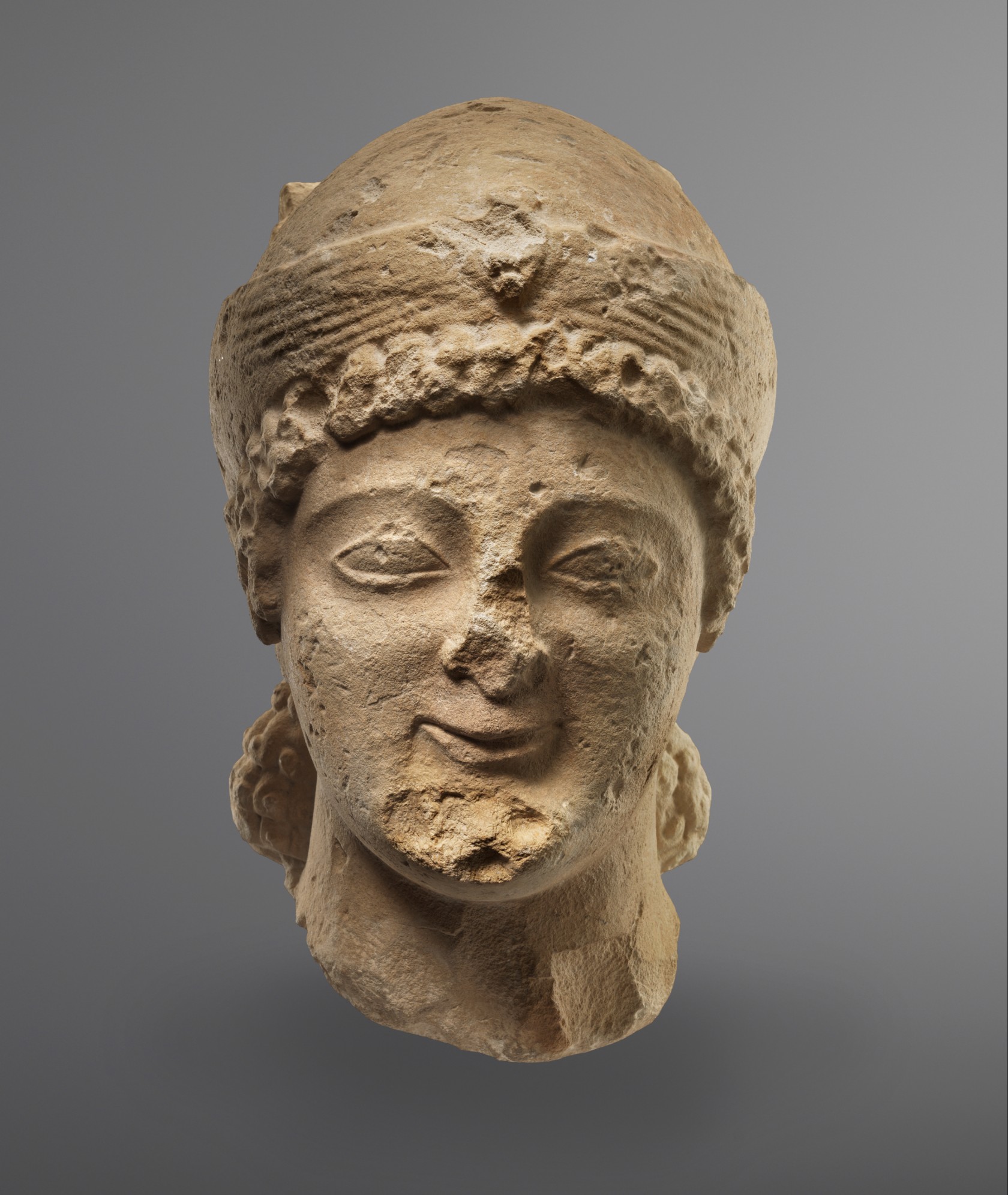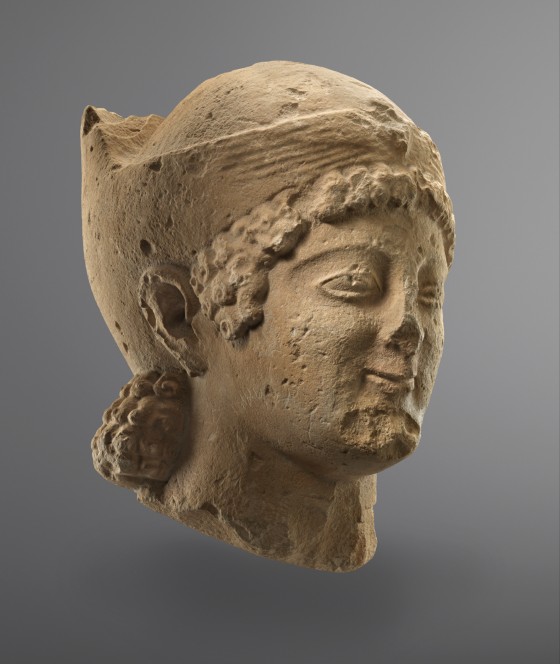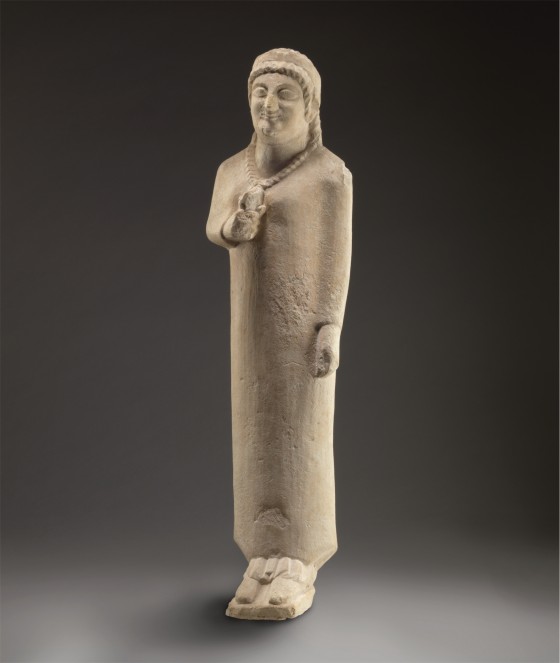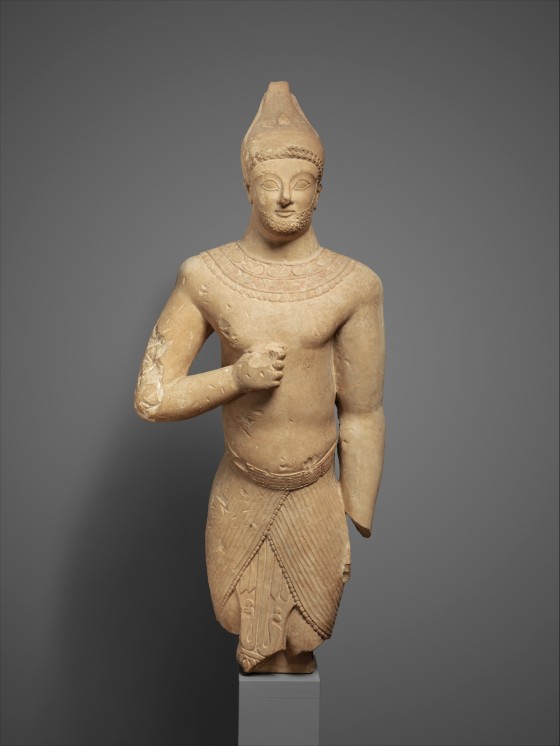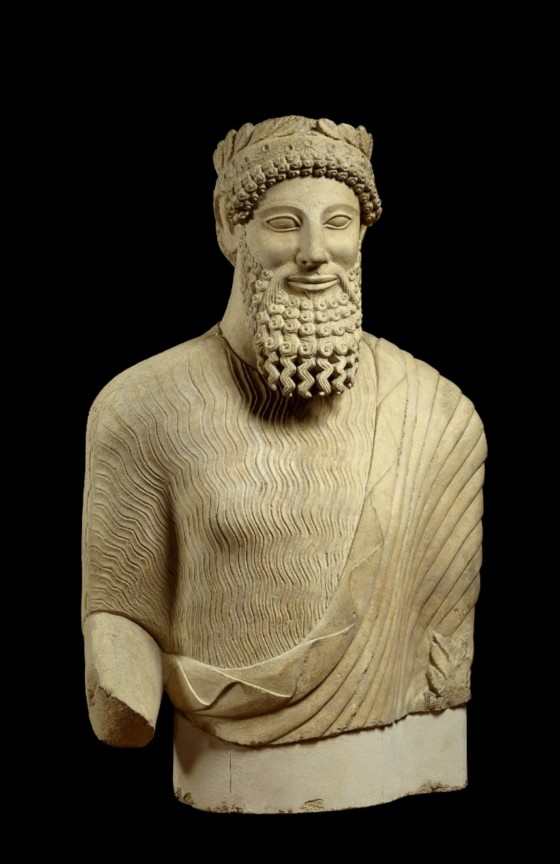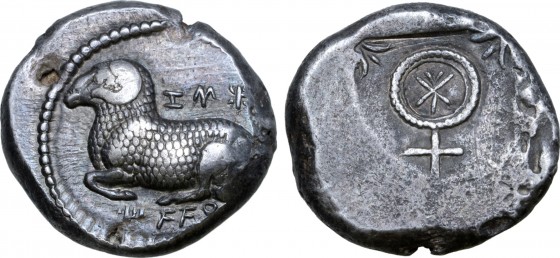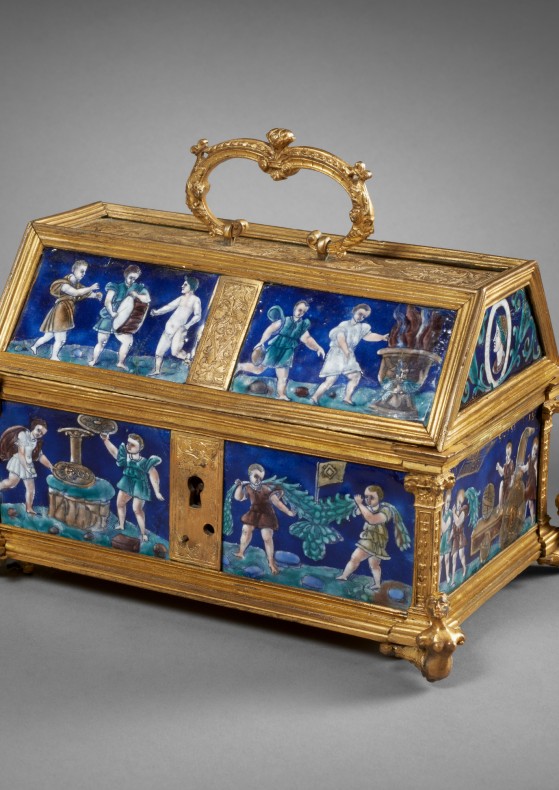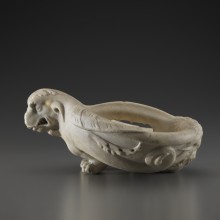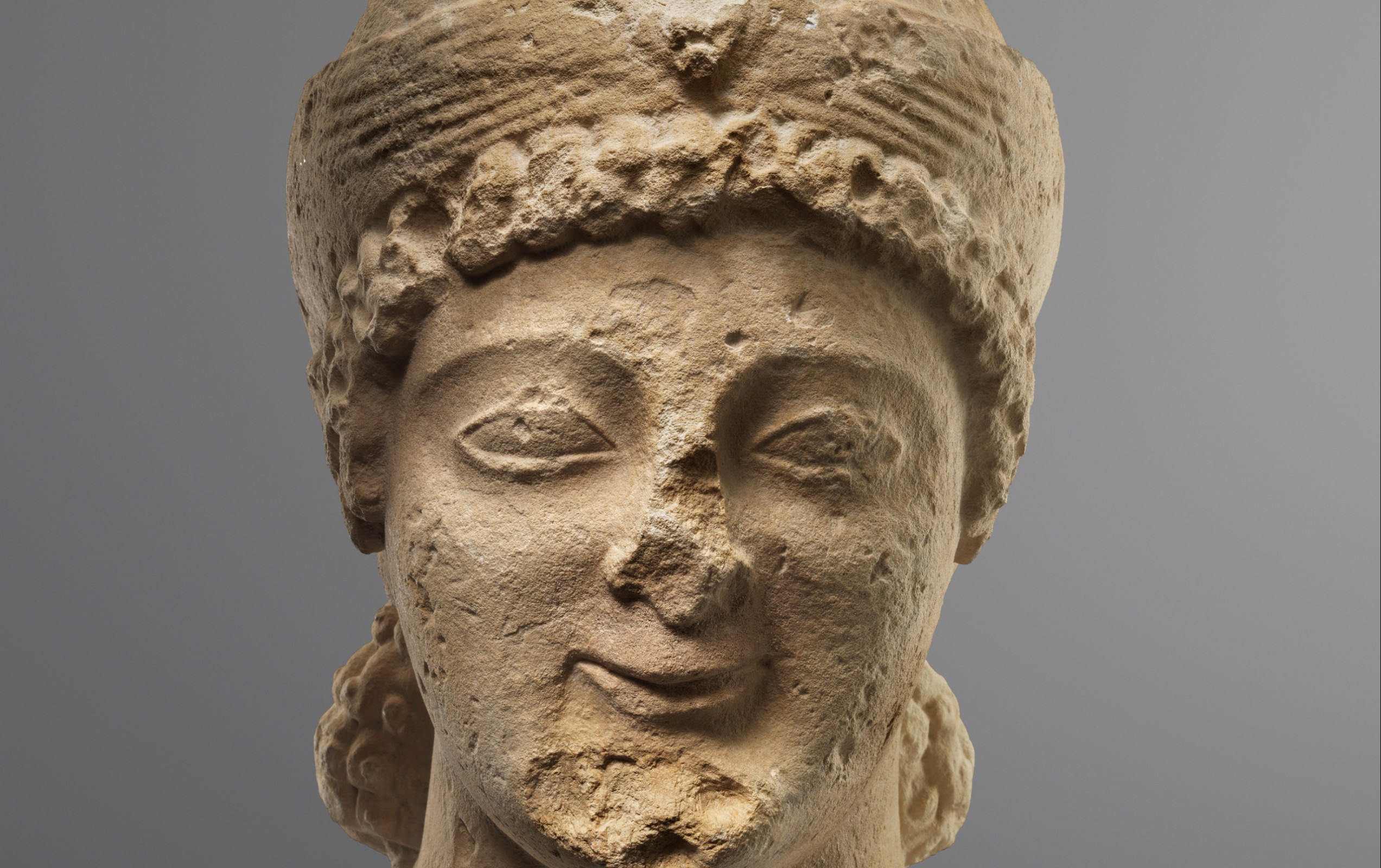
September 2019 Archaeology
Head of a young prince depicted as a pharaoh
Have a guess: of which origin is this young man’s head? Greek or Egyptian?
See the artwork in the collectionHead of prince
Cyprus, end of the VIth Century BC
Limestone
37 x 20 x 26 cm
FGA-ARCH-GR-0125
Provenance
Galerie Simone de Monbrison, Paris, before 1980
Then collection Jean-Pierre Farnier, Boulogne, acquired in 1981 at the galerie Simone de Monbrison
Then collection Michel Faidutti, Geneva
Then Galerie Sycomore, Geneva
Acquired at the galerie Sycomore, Geneva, 13 June 2018.
Unpublished
In 2018, the archaeological collection of the Fondation Gandur pour l’Art welcomed a young Cypriot prince, or more precisely his portrait, since we are considering a magnificent head pertaining to a life-size statue (fig. 1 and 2). Although the prince’s name remains unknown, this piece gives us a glimpse into the perception of kingship in Cyprus in the 6th century BC.
A princely head which already ranks among the flowers of ancient Cypriot sculpture…
A certain idea of perfection
Sculpted in a fine-grained, dense and heavy white limestone with yellow tint, this head is a true masterpiece! Its material, a high-quality Cypriot limestone, was sculpted in the round without breaking. This is quite an achievement, as the very friable limestone found in Cyprus consists of thin slabs, which gives the local statues made of it a distinct feature: their back is flat, as is the case for another statue in our collections (a female offering-bearer, fig. 3 and 4).
This head of remarkable dimensions also shows a great plastic sense: the treatment of the face is firm and clear, and the headgear fitting closely over the skull is perfectly fixed on the head. The neck, high and wider at the base, gives it a graceful look.
You almost expect him to speak
This angelic face radiates with life, and as beholders, we are under the impression that his smile is directly addressed to us… this is due to the treatment of the features such as cheeks and chin, eyebrows and ears, carved with meticulous care, in a mixture of idealization and realism. His hair, for instance, shows a mass of regularly organized snail-shaped locks protruding from the headgear and formed as a fringe on the forehead and sideburns in front of the ears, but is neatly gathered in a foaming mass covering the nape. Long eyelids above almond-shaped eyes, the pupils of which were incised, a thin curved smile on his lips, as well as a rather wide chin, all contribute to identify this individual as coming straight out of the Antiquity. And if time did inflict some damage to it – as is often the case, the nose has gone and the chin is partly chipped –, this did not alter its beauty.
Although it belonged to several private collections since long ago, this sculpted head has never been studied in detail, a lacuna which shall soon be filled.
Egypt and Greece united in the same masterpiece
The specificities of the limestone used, the aesthetic peculiarities of this head and its dimensions, which suggest that it pertained to a life-size statue, bear witness to its very high quality. This piece can be compared to the best statues of individuals belonging to the upper classes of ancient Cypriot society, like those kept at the Cyprus Museum of Nicosia, the Louvre, the British Museum or the Metropolitan Museum.
Moreover, this head displays two unusual features: the headgear, and the physical characteristics or a kouros. Let us first consider this very peculiar headgear, which is reminiscent of the Pharaonic crown called pschent, a combination of the ‘white’ crown (symbolising the Pharaoh’s dominion over Upper Egypt), and of the ‘red’ crown (dominion over Lower Egypt), which was equipped with a protruding coil at the front, the khabet. In Egypt, this ‘double crown’ was the most common royal headgear from the Old Kingdom onwards.
In the present case, the pschent is reinterpreted in the Cypriot manner: here the ‘white’ crown is shaped as close-fitting helmet, although one must imagine the missing bulb ending, and the ‘red’ crown surrounds it. Like its Egyptian model, the back part of the pschent extends upwards, and the forepart is adorned with a winged uraeus: a rearing cobra (the shape of which is still perceptible) whose wide wings deploy on the crown’s edge, which is not equipped with a khabet. As a power attribute taken out of its original context, i.e. the expression of the unification of Upper and Lower Egypt, the pschent would assume a new meaning in Cyprus.
Under this crown, a rather young man with the plain cheeks and the charming look and smile of a Greek kouros radiating a great serenity. This gentleness is reminiscent of the kouroi of Eastern Greece.
In the Classic period, Cypriot kings would usually show a beard made of snail-curls, a sign of maturity
Grandeur of Cypro-Archaic art
With its rather thin-lipped smile and Egyptian crown, this young man’s face summarizes the nature of Cypro-Archaic art: a fine and easily identifiable blend of Egyptian, Greek and Near-Eastern influences which flourished between the mid-7th and the early 5th century BC in the welcoming and fertile ground of Cyprus. A rich island with a strong personality located at the crossroads of important trade routes, Cyprus integrated foreign influences, soon to recreate something new. In a way, this Cypro-Archaic art represents the apex of cultural mix in the Mediterranean.
You can’t see the wood for the trees
Is this the only head wearing the pschent? Not at all, a few others are known: to this day, 18 Cypriot limestone heads wearing this crown are known, and there might be even more lying dormant in other private collections. In 1994, Melitta Brönner recorded 14 of them made of stone1, to which must be added three other heads from the former collection De Clercq2, as well as the one presented here. The provenance of some of them is also known: two were discovered in Palaepaphos, three in Golgoi, one in Malloura very close to Golgoi, and finally one in Aloa, in the vicinity of Salamis. They were thus widely spread nearly over the entire island.
The late 6th century BC
However, only one of them was found in a dated archaeological context. It came from the “Persian siege ramp” at Palaepaphos, built in 498 BC. This episode must be replaced in the context of the Persian wars, when Persians subdued the revolt of Cyprus kingdoms. During the siege of ancient Paphos, they used all they could find – and notably statue fragments from a nearby sanctuary – to build an improvised access ramp. The statue to which this head pertained had been sculpted before this date, and its style enables to date it to 525 BC approximately. It probably depicts Onasicharis, who was king of Paphos shortly before the siege of the venerable city3. The FGA head might be of a slightly later date, and I propose to date it to 515-500 BC.
Moreover, these statues of men wearing an Egyptian crown belong to a larger ensemble of male Egyptianizing statues of the Archaic period which has been well studied by Fanni Faegersten4.
What did the complete statue look like?
It was a large one: indeed, this head pertained to a standing figure, as suggested by the preserved examples of this statue type. Considering its dimensions (37 cm), one can estimate its original height to a little more than 1.60 m. In the category of the figures wearing the pschent, the FGA head is therefore one of the tallest, next to the two statues from Golgoi, estimated at 1.77 and 1.78 m. If some of these Egyptianizing statues are colossal (like a statue from Golgoi which was more than 3.65 m high)5, many of them do not exceed 70 cm6.
If we consider the few statues wearing the pschent whose body was preserved (fig. 5 and 6)7, our young man was also dressed in the Egyptian way. Along with a broad necklace, a Cypriot interpretation of the ousekh pectoral, otherwise bare-chested, he must have been wearing a plaited shendjit-kilt. This kilt was richly adorned with two snakes inspired by the Egyptian uraeus, sometimes associated with a grimacing head resembling Bes, a god linked with royal power in Cyprus8. Looking ahead with his arms along his body, or one arm against his chest and closed hand, our young man would stand straight, his left leg placed slightly forward. Again, this posture is also inspired by depictions of pharaohs holding their scepter9, but it was widely spread in the eastern Mediterranean basin. The majesty emanating from these statues therefore results from the interaction between the attitude, garments and attributes depicted.
The present statue was thus depicting a man “in majesty” before a god: like the vast majority of the ancient statues found in Cyprus, it was an ex voto meant to be exhibited in a sanctuary, as a votive offering to the deity. And like all these ex votos, it must have been painted with bright colours, which are sometimes preserved; unfortunately, in this case, nothing remains of these colours.
Who might be this young man?
These Egyptianizing regalia are not those of Egyptians installed in Cyprus. As mentioned already, the quality of the sculpture suggests that the person who commissioned it could afford the skills of an excellent sculptor and a high-quality material, as can be observed in other cases.
Moreover, the individual depicted also wears attributes of kingship. All these clues suggest that the young man considered was a king or, judging from his young age, a prince. Indeed, as the two statues kept at the Metropolitan Museum (fig. 5 and 6) suggest, Cypriot heads wearing a pschent can be classified into two categories: the beardless and the bearded.
In the Classic period, Cypriot kings would usually show a beard made of snail-curls, a sign of maturity (fig. 7)10 also associated – theorically – with wisdom acquired through knowledge and experience. This is the main quality of a good king.
The question whether the man depicted was a king or a prince remains unanswered. In the present state of our knowledge, it is hard to ascertain where this head came from, so he must remain an anonymous prince. In all likelihood, he must have belonged to a dynasty ruling one of the kingdoms of Cyprus at the end of the 6th century BC.
Priest-kings
All these Egyptianizing depictions cover a period between the first quarter of the 6th and the last quarter of the 5th century BC, in other words the “period of the Kingdoms”. The island was then divided into seven, then into ten, entities ruled by kings: the most venerable of these were the kingdoms of Paphos and Amathus, famous for their sanctuary devoted to the wanassa, the main protecting goddess of the island, whom the Greeks associated with Aphrodite. In both of these kingdoms, the king would also assume the duties of high priest of the goddess11.
What does a Cypriot king dream of?
For Cypriot kings, pharaohs were the epitome of royal power: an unquestioned authority over a vast territory, supported by gods. This is probably why they borrowed the outward signs of pharaonic power to underline, in their own way, their royal nature. In the late 6th century BC, coins minted by Evelthon, king of Salamis, were even adorned with the life-sign ankh on their reverse (fig. 8):
another evidence of the foremost appeal and status of everything related to Egypt. And in the kingdom of Amathus, the Egyptian model was so favoured that local kings even used stamp seals inspired by the cartouches of the pharaohs…
Dr Isabelle Tassignon
Curator of the Archaeology Collection
Notes and references
- Brönner, « Heads », p. 48-51.
- De Ridder, Collection De Clercq, p. 67, n° 22, p. 68, n° 24, p. 71, n° 29.
- Hermary, « Témoignages des documents figurés », p. 180.
- Faegersten, The Egyptianising Male Limestone.
- Faegersten, The Egyptianising Male Limestone, p. 278, cat. 22.
- Faegersten, The Egyptianising Male Limestone, cf. pl. 22-45.
- Metropolitan Museum, inv. 74.51.2472 (mid VIth century BC) and inv. 74.51.2472 (third quarter VIth century BC).
- Tassignon, Le « Seigneur aux lions », pass.
- Faegersten, The Egyptianising Male Limestone, p. 77-78.
- British Museum, inv. 1917,0701.233, from Idalion, dated 500-480 BC.
- Maier, « Priest Kings », p. 376-380; Satraki, « The iconography of Basileis », pass.
Bibliography
Brönner, Melitta, « Heads with double crowns », in Vandenabeele, Frieda, Laffineur, Robert, Cypriote Stone Sculpture. Proceedings of the Second International Conference of Cypriote Studies, Brussels-Liège, 17 – 19 May, 1993, Bruxelles-Liège, 1994, p. 47–53.
De Ridder, André, Collection De Clercq. V. Les antiquités chypriotes, Paris, Ernest Leroux éditeur, 1908.
Faegersten, Fanni, The Egyptianizing Male Limestone Statuary from Cyprus. A study of a cross-cultural Eastern Mediterranean votive type, PhD Lund University, 2003 (unpublished thesis).
Hermary, Antoine, « Témoignages des documents figurés sur la société chypriote d’époque classique », in Peltenburg, Edgar, Early Society in Cyprus, Edinburgh University Press, Edinburgh, 1989, p. 180-196.
Maier, Hans-Georg, « Priest Kings in Cyprus, in Peltenburg, Edgar, Early Society in Cyprus, Edinburgh University Press, Edinburgh, 1989, p. 376-391.
Satraki, Anna, « The Iconography of Basileis in Archaic and Classical Cyprus: Manifestations of Royal Power in the Visual Record », Bulletin of the American Schools of Oriental Research, 370 (2013), p. 123-144.
Tassignon, Isabelle, Le « Seigneur aux lions » d’Amathonte. Étude d’iconographie et d’histoire des religions des statues trouvées sur l’agora, De Boccard, Athènes-Paris, 2013 (Études chypriotes, XVIII).

